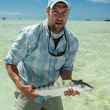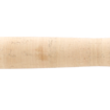Not long ago, RIO released its new saltwater fly line designed specifically for fishing for permit -- which was awarded Best New Saltwater Fly Line at IFTD 2014 -- and has no trouble moving them off the shelves. Retailers have reported the lines selling faster than RIO can make them. This is most certainly good news for RIO, but perhaps the even better news is that so many lucky anglers are off chasing permit, toting RIO's new line along for the pursuit.
RIO designed its new permit line to handle the needs of permit fishermen and has spent the last year or so testing the line and tweaking its tapers in places like Belize, Mexico and other permit-rich locales. According to RIO's Simon Gawesworth, the line is designed to be stable at long and short distances and to allow anglers to pick up line, load their rods quickly and deliver typical permit flies (like crab patterns) with accuracy. These demands are typical of permit fishing, where the name of the game is often not just about getting your initial cast on the spot, but being able to quickly and accurately retarget a moving fish.





























